Starting a small home daycare can be an exciting and rewarding venture. Whether you’re looking to work from home, offer a nurturing environment for children, or just explore an entrepreneurial path, setting up your daycare in a small space requires careful planning and creativity. You need to create a safe, comfortable, and engaging environment for kids while maximizing the limited space you have.
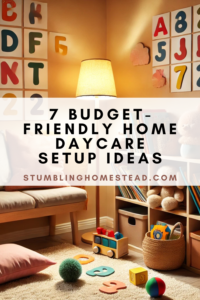
1. Choosing the Right Space for Your Daycare
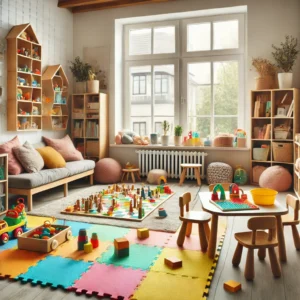
When setting up a home daycare, choosing the right area of your home is crucial. This space should be safe, easily accessible, and able to meet the developmental needs of the children you’ll care for.
Key Factors to Consider:
- Accessibility: Ensure that the space is easily accessible to parents dropping off and picking up their children. A dedicated entrance or a space near the front of the house can reduce congestion.
- Safety: The space should be free of hazards. Consider outlets with covers, childproofing sharp corners, and securing furniture to walls to prevent accidents.
- Natural Light: Children thrive in bright environments. Ensure the space receives plenty of natural light. This can be achieved through windows, glass doors, or even mirrors to reflect light.
- Ventilation: Make sure there is proper ventilation to ensure the air is fresh and clean. Openable windows and ceiling fans are a good start.
- Multi-functional Spaces: Since your home is small, you might need to use rooms for multiple purposes. For example, a living room can serve as both a play area and a nap room.
2. Play Area Setup
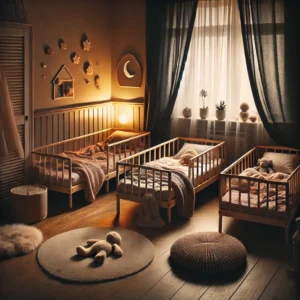
The play area is the heart of any daycare. For a small space, it’s important to organize it in a way that promotes learning and play without making the space feel cluttered.
Creating an Inviting Play Area:
- Soft Flooring: Use foam mats or soft rugs to protect children from falls. These can also be colorful and add to the decor of the room. A rug with fun patterns like animals, numbers, or shapes can make the space more engaging.
- Open Shelving: Use open shelves to store toys and books. This allows children to access their toys independently and helps with organization. Label each shelf or toy bin with pictures or words to encourage literacy skills.
- Interactive Stations: Designate different corners for specific activities—one for building blocks, another for arts and crafts, and one for imaginative play with dolls or toy kitchen sets. This separation helps reduce chaos and teaches children to focus on one activity at a time.
- Storage Solutions: In small spaces, storage is key. Invest in compact storage solutions, such as stackable bins, baskets, or even under-bed storage. This keeps the space neat and organized while providing easy access to toys and learning materials.
3. Creating a Comfortable Nap Area
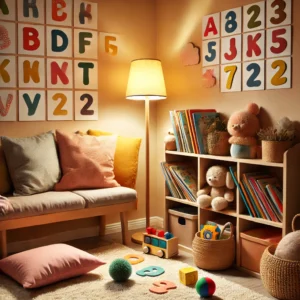
Naptime is essential for children, and you’ll need to carve out a comfortable area in your daycare. In a small home daycare, this could be a challenge, but it’s manageable with a little creativity.
Maximizing Nap Time Comfort:
- Use a Separate Room (If Possible): If your space allows, have a quiet room for naptime. This will help children sleep without the distraction of playtime. It doesn’t need to be a large room; even a small corner with a few cots or mats will suffice.
- Bedding and Cots: Purchase child-sized cots or sleeping mats that can easily be stored away when not in use. These should be comfortable but compact, allowing you to free up space during non-nap hours.
- Dim Lighting: Install blackout curtains to create a calm environment during nap time. If blackout curtains aren’t feasible, you can also use a soothing nightlight or a soft light to help kids wind down.
- Quiet Activities: Consider having quiet activities for children who don’t sleep immediately, such as soft books or puzzles.
4. Designing the Learning Space
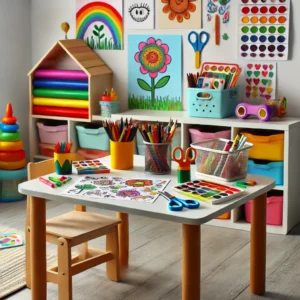
In addition to play and nap areas, a home daycare should foster early childhood learning. This doesn’t mean a classroom setting, but rather incorporating learning materials and activities that encourage cognitive and emotional growth.
Establishing a Learning Environment:
- Reading Corner: Set up a cozy reading nook with a variety of age-appropriate books. Use cushions or bean bags for comfort, and include a bookshelf that’s within the children’s reach so they can choose books themselves.
- Art Station: Designate an area for arts and crafts. This should have tables or easels, child-safe scissors, crayons, markers, and large sheets of paper for drawing. Encourage creativity with open-ended art projects.
- Educational Toys: Invest in toys that promote problem-solving, fine motor skills, and learning. Puzzles, shape sorters, stacking toys, and building blocks are all great options.
- Visual Learning Tools: Use wall-mounted posters or bulletin boards that display the alphabet, numbers, shapes, or other educational material. These can be changed seasonally or themed to keep things fresh.
5. Setting Up a Safe and Functional Kitchen Area
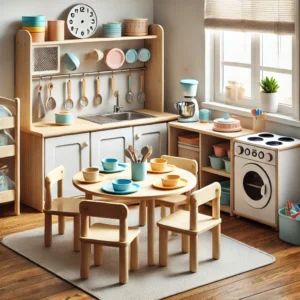
Since you will be working in a small space, your kitchen will need to function both for meal preparation and as an area to demonstrate healthy eating habits to the children.
Making the Kitchen Work for You:
- Snack and Meal Prep Space: Create a small snack or meal prep area. A child-friendly table where kids can sit and eat together helps create a community feel during snack time. Make sure to have space for storing any child-friendly plates, cups, and utensils.
- Child-Sized Furniture: Invest in a small table and chairs that are the right height for young children. This helps them practice independence as they feed themselves.
- Safety Measures: Ensure the kitchen is fully childproofed. Keep sharp objects, cleaning supplies, and hot items out of reach. Install childproof locks on cabinets and drawers.
- Sanitization Station: Have a designated space for washing hands, both for the children and for you. A small sink area or portable hand-washing station will help maintain hygiene standards.
6. Outdoor Play Area
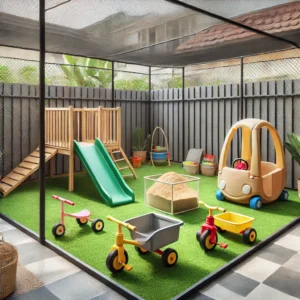
If you have a yard or even a small outdoor space, this can be a great asset for your daycare. Outdoor time is essential for children’s physical development, and it can give them the opportunity to burn off energy.
Ideas for Outdoor Spaces:
- Fenced Yard: A small, secure, fenced-in yard will give children a safe space to play. If you don’t have a fenced yard, consider using a playpen or portable fencing for smaller areas.
- Toys for Outdoor Play: Set up age-appropriate outdoor toys such as tricycles, balls, small slides, or sandboxes. If space allows, a small water table or a garden area for planting can engage kids with nature.
- Shaded Area: In warmer months, ensure that there’s a shaded spot where children can cool off. This could be an umbrella, a canopy, or a tree to protect from direct sunlight.
- Safety Check: Regularly check the outdoor area for any hazards like sharp objects, poisonous plants, or slippery areas. Ensure that any outdoor play equipment is sturdy and appropriate for young children.
7. Setting Up a Daily Routine and Structure
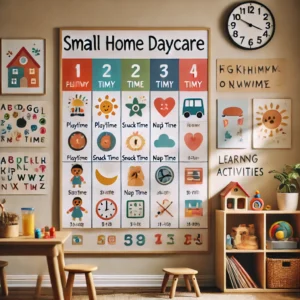
A key element of any successful daycare is structure. Children thrive on routines, and a well-organized day will keep both you and the kids on track.
Routine Tips for a Small Home Daycare:
- Create a Schedule: Establish a predictable routine for meals, naps, playtime, and learning activities. Having a visual schedule (with pictures) can help young children understand what comes next.
- Time for Socializing: Incorporate group playtime to help children build social skills. This can be during snack time, circle time, or shared activities like singing songs or reading stories together.
- Flexibility: While routines are important, also allow for flexibility. Kids might have different needs each day, and adjusting your schedule as needed will help maintain a calm and supportive environment.
Conclusion: Making Your Small Home Daycare Thrive
Running a small home daycare is a balancing act of creating a space that’s safe, engaging, and functional—all while keeping in mind the limited square footage you have. By utilizing clever storage solutions, separating areas for different activities, and investing in multifunctional furniture, you can create a daycare that feels spacious, safe, and enjoyable for the children you care for. With the right setup, your small daycare can flourish into a place where kids thrive, and parents feel confident in leaving their children with you.
